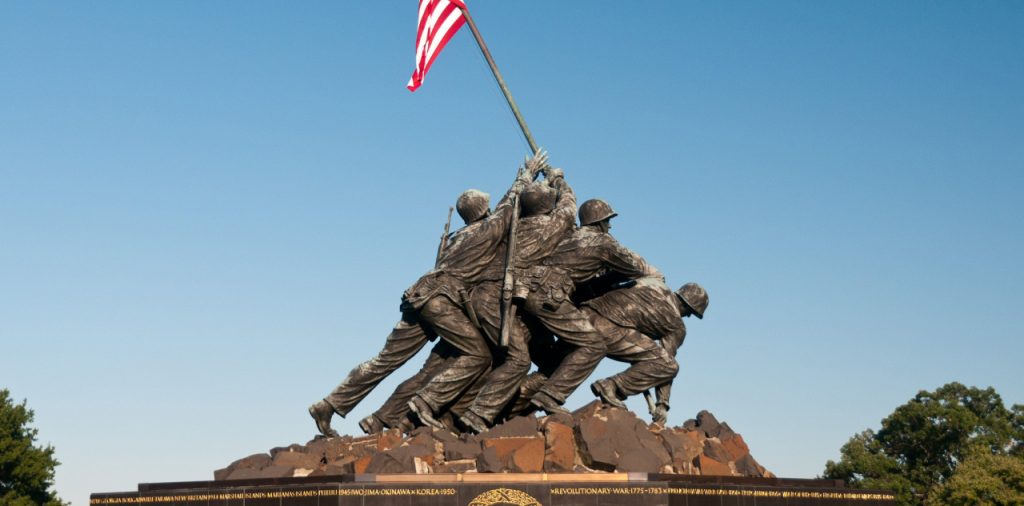If you plan to visit Washington D.C. consider including the US Marine Corps War Memorial in your itinerary. This impressive monument, also known as the Iwo Jima Memorial, honors the Marines who have died in service since 1775. It is near Arlington National Cemetery and offers a stunning view of the capital’s landmarks. Here are some things you should know about this memorial before you go.

History
The US Marine Corps War Memorial was inspired by a famous photograph of Joe Rosenthal on February 23, 1945, during the Battle of Iwo Jima in World War II. The photo shows six Marines raising the American flag on top of Mount Suribachi, a volcanic peak on the island. The image symbolized victory and patriotism and was reproduced in newspapers, magazines, stamps, and posters.
The sculptor Felix de Weldon, who served in the Navy then, was so moved by the photo that he created a miniature model on a single weekend. He later proposed to make a more prominent statue for a national memorial. Still, he had to wait until after the war to get funding and approval from Congress. In 1951, he began working on the full-scale sculpture, which took three years to complete. He used plaster molds and cast the statue in bronze. He also used some equipment the flag-raisers wore, such as helmets, canteens, and cartridge belts.
The memorial was dedicated on November 10, 1954, the 179th anniversary of the Marine Corps. President Dwight D. Eisenhower and Vice President Richard Nixon attended the ceremony with three surviving flag-raisers: Rene Gagnon, Ira Hayes, and Harold Schultz. The other three flag-raisers, Harlon Block, Franklin Sousley, and Michael Strank, had died in action on Iwo Jima.
Cultural Significance
The US Marine Corps War Memorial is more than just a statue. It is a tribute to the courage and sacrifice of all Marines who have served and died for their country. It also represents the ideals and values of the Marine Corps, such as honor, loyalty, and commitment. The memorial’s inscription reads: “Uncommon Valor Was A Common Virtue” and “In Honor And Memory Of The Men Of The United States Marine Corps Who Have Given Their Lives To Their Country Since 10 November 1775”.
The memorial has also been featured in many movies, books, and songs that depict the history and culture of the Marines. Some examples are Flags of Our Fathers (2006), The Pacific (2010), and Semper Fi (2019).
Points of Interest
The US Marine Corps War Memorial is not just a single statue but a complex of elements that enhance its meaning and beauty. Here are some of the features that you should pay attention to when you visit:
The Statue
The statue is 32 feet high and weighs 100 tons. It depicts the six flag-raisers in their combat gear, with their faces showing determination and strain. The flagpole is 60 feet long and holds a cloth flag that flies day and night. The statue is oriented so that it faces southeast, towards the National Mall and the Washington Monument.
The Base
The statue’s base is black granite and has a gold inscription on its front. It also has four bronze plaques on its sides that list the names of all the major battles involving the Marines since 1775.
The Grounds
The statue stands on a circular platform surrounded by a low wall with two arches. The platform is paved with gravel and has a diameter of 210 feet. The barrier has 13 stars representing the original colonies and two laurel wreaths symbolizing victory. The arches have inscriptions that read “Semper Fidelis” (Always Faithful) and “Semper Prorsus” (Always Forward), which are mottos of the Marine Corps.
The Flag
The flag that flies over the memorial is not an ordinary one. It is a special ceremonial flag that has 48 stars, which was the number of states in 1945 when the flag was raised on Iwo Jima. The flag is changed annually on February 23rd by a group of Marines who reenact the flag-raising ceremony.
Interesting Facts
Here are some interesting facts about the US Marine Corps War Memorial that you might not know:
- The statue is based on the second flag-raising on Iwo Jima, not the first one. The first flag was raised earlier that day by a different group of Marines, but it was considered too small to be seen from afar. The second flag was more prominent and more visible, and it was captured by Rosenthal’s camera.
- The statue is not an exact replica of the photograph. De Weldon made some changes to the positions and proportions of the figures to create a more balanced and dynamic composition. He also added some details that needed to be visible in the photo, such as the facial features and the equipment.
- The statue is the most giant bronze statue in the world. It took 12 tons of bronze to cast and was transported in three sections from New York to Virginia by truck. It was then assembled and welded on-site by de Weldon and his assistants.
- The statue is not technically on US soil. It is located on a piece of land donated by the Netherlands to the United States in 1954 as a gesture of gratitude for the liberation of Holland during World War II. The land is considered a part of the Netherlands Carillon, a bell tower next to the memorial.
Advice for Visitors
If you want to visit the US Marine Corps War Memorial, here are some tips to make your experience more enjoyable and memorable:
When is it open?
The memorial grounds are open year-round from 6 a.m. until midnight. However, the best time to visit is during the summer, when you can watch the Sunset Parades on select Tuesdays. These one-hour performances feature the music of “The Commandant’s Own,” The United States Marine Drum and Bugle Corps, and precision drill by the Marine Corps Silent Drill Platoon.
You can check their website for further information.
What to wear?
There is no dress code for visiting the memorial, but you should dress comfortably and appropriately for the weather. You should also wear shoes that are suitable for walking on gravel. If you are attending the Sunset Parades, consider bringing a jacket or a blanket, as it can get chilly in the evening.
Is it family-friendly?
Yes, the memorial is a great place to visit with your family, especially if you have children interested in history and the military. You can teach them about the memorial’s significance and the Marines’ role in defending the nation. You can also take photos of the statue and enjoy the view of the capital.
When is it best to visit?
The best time to visit the memorial is sunrise or sunset when you can see the statue illuminated by natural light and contrasted with the sky. You can also see the flag waving in the wind and hear its sound. You can also avoid the crowds and have a more peaceful and reflective experience.
Trip drive through Washington D.C.: From Washington National Cathedral to Avesta Ketamine
Direction 1: Washington National Cathedral
3101 Wisconsin Ave NW, Washington D.C. 20016, United States
- Head east on Woodley Rd NW toward 36th St NW (0.2 mi)
- Turn left onto 34th St NW (0.5 mi)
- Continue onto Reno Rd NW (0.2 mi)
- Turn right onto Tilden St NW (0.7 mi)
- Turn left onto Linnean Ave NW (0.2 mi)
- Turn right, Destination will be on the right (0.1 mi)
Direction 2: Hillwood Estate, Museum & Gardens
4155 Linnean Ave NW, Washington D.C. 20008, United States
- Take Linnean Ave NW to Tilden St NW (2 min, 0.3 mi)
- Head southwest toward Linnean Ave NW (0.1 mi)
- Turn left onto Linnean Ave NW (0.2 mi)
- Continue on Tilden St NW. Take 34th St NW to Observatory Cir NW (7 min, 1.9 mi)
- Turn right onto Tilden St NW (0.7 mi)
- Sharp left onto Reno Rd NW (0.3 mi)
- Continue onto 34th St NW (1.0 mi)
- Turn right onto Massachusetts Ave NW (240 ft)
- Continue on Observatory Cir NW to Wisconsin Ave NW (2 min, 0.4 mi)
- Turn left onto Observatory Cir NW (0.2 mi)
- Continue onto Calvert St NW (0.1 mi)
- Turn left onto Wisconsin Ave NW
- Pass by FedEx Office Print & Ship Center (on the right) (3 min, 0.6 mi)
- Continue on South St NW
- Drive to 32nd St NW (1 min, 0.2 mi)
- Turn left onto South St NW (0.2 mi)
- Turn right onto 32nd St NW
- Destination will be on the left (210 ft)
Direction 3: Dumbarton Oaks Museum
1703 32nd St NW, Washington D.C. 20007, United States
- Take 34th St NW to M St NW (5 min, 0.8 mi)
- Head south on 32nd St NW toward R St NW (154 ft)
- Turn right onto R St NW (0.2 mi)
- Turn left onto 34th St NW (0.6 mi)
- Take Francis Scott Key Bridge/Key Bridge, Fort Myer Dr/N Ft Myer Dr, I-66 E, Exit 75 and VA-110 S to N Marshall Dr in Arlington (4 min, 1.4 mi)
- Use the right 2 lanes to turn right onto M St NW (233 ft)
- Use the left 2 lanes to turn left onto Francis Scott Key Bridge/Key Bridge (Entering Virginia, 0.3 mi)
- Continue onto Fort Myer Dr/N Ft Myer Dr (0.2 mi)
- Turn left onto Langston Blvd (489 ft)
- Use the right 2 lanes to take the ramp to I-395/Roosevelt Brg (0.2 mi)
- Merge onto I-66 E (0.2 mi)
- Take exit 75 for VA-110 S toward I-395/US-1/Pentagon City/Crystal City/Reagan Nat’l Arpt/Alexandria (0.2 mi)
- Continue onto VA-110 S (0.2 mi)
- Follow N Marshall Dr to Iwo Jima Acc Rd/U.S. Marine Corps War Memorial Access Rd (21 sec, 456 ft)
- Turn right onto N Marshall Dr (417 ft)
- Turn right onto Iwo Jima Acc Rd/U.S. Marine Corps War Memorial Access Rd (39 ft)
Direction 4: US Marine Corps War Memorial
Arlington, VA 22209, United States
- Get on US-50 E/Arlington Blvd from N Marshall Dr and N Meade St (2 min, 0.6 mi)
- Head south on Iwo Jima Acc Rd/U.S. Marine Corps War Memorial Access Rd toward N Marshall Dr (39 ft)
- Turn right onto N Marshall Dr (0.2 mi)
- Turn right onto N Meade St (0.2 mi)
- Take the ramp onto US-50 E/Arlington Blvd (0.1 mi)
- Take I-66 E to L St NW in Washington D.C. (4 min, 1.8 mi)
- Merge onto US-50 E/Arlington Blvd (0.1 mi)
- Keep left at the fork, follow signs for US-50 E/Washington D.C. and merge onto I-66 E (Entering District of Columbia, 0.8 mi)
- Use the left lane to take the I-66 E exit toward E Street (0.1 mi)
- Keep left, follow signs for Whitehurst Freeway (453 ft)
- Continue onto I-66 E (0.4 mi)
- Use the right lane to take the Whitehurst Frwy exit (0.1 mi)
- Keep right, follow signs for Pennsylvania Avenue and merge onto L St NW (0.2 mi)
- L St NW turns right and becomes Pennsylvania Avenue NW (154 ft)
- Slight left onto L St NW (2 min, 0.2 mi)
- Turn left onto New Hampshire Ave NW (4 min, 0.5 mi)
- At Dupont Cir NW, take the 4th exit onto P St NW (4 min, 0.4 mi)
- Turn right onto 16th St NW (16 sec, 164 ft)
- Turn right, Destination will be on the right (5 sec, 69 ft)
Direction 5: Avesta Ketamine and Wellness
1400 16th St NW Suite 101, Washington D.C. 20036, United States
